A PILGRIM'S GUIDE OF TOULOUSE
Generalities
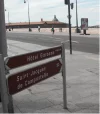
Toulouse, also known as "La Ville Rose" (because of the pinkish color of its old buildings) is an ancient, charming and lovely city, the largest of southwestern France. It used to be a quiet provincial place, but in recent times it evolved into a high tech hub, notably with the huge Airbus headquarters. It is also an arts and cultural center, with a vibrant urban life.
And how not to love a city whose official flower is the violet, which symbolizes modesty, gentleness and hidden love? Violets have its own festival dedicated to all things related to the flower, and you can buy violet based sweet treats, cosmetics (soaps, eau de toilette, parfums), scented tea and liqueurs. In early March, usually.
You will notice the street names and metro stations written in Occitan (the old regional language, which predated modern French).
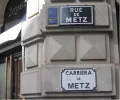
Toulouse has always been an important stop in the Arles way, already mentioned in the medieval chronic of Aymeric Picaud. Also, there is a “transversal” route that links the city with Conques (in the Le Puy way).
It is also possible, with a short hop by train, connect with the scenic Piedmont way, for example in Carcassonne. Or, alternatively, walk to Saint Bertrand de Comminges by the new Via Garona, the GR 861.
Generally speaking, Toulouse is a safe place (and its inhabitants are really, really polite). Anyway, take the usual, common sense precautions you'd use in any big city.
Trains, planes and navettes
If you start your pilgrimage at Toulouse you will arrive by train or plane.
The Matabiau train station is very centric; you can connect there with the metro (see “transportation”, below)
The Blagnac airport is not far from the city. You can take the express bus (navette) that goes every 20 minutes to downtown, with final destination at Matabiau. Not expensive, just 8 euros, and your ticket is also good for the metro for 1 1/2 hour after you bought it. Time to/from downtown: 20 to 45 minutes, depending on the traffic.
Another (and new) option is the tramway line T2. You leave at Arènes and connect to metro with the same ticket. It could be more crowded.
There are taxis at the airport, too.
Arriving by the Arles way
Pilgrims doing the Arles way typically start the previous stage in Baziège (attention: communal gîte closed, currently there is an alternative at Ayguevives). There are two arrival options to Toulouse: the GR (marked with the typical red and white strips signposts) that goes along the Garonne river; and the alternative and popular walk along the Canal (channel) du Midi that drives the walker practically into midtown (see this map), indicated with the familiar arrows and shells (placed high, besides the usual urban signposts).
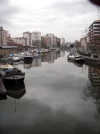
Credential and stamps
At Basilica of Saint Sernin there is a pilgrim's bureau, managed by volunteers of Amis de Saint Jacques de Compostelle association. It is open from 1st Avril to October 31th, 15h – 18 hs.
Another option is ACIR Compostelle, a public association. It is at Clémence Isaure 4. See opening hours here.
Both places receive pilgrims warmly, and give help and advices.
Lodgment
Well, this is a difficult topic. You can see mentions of some public and ecclesiastical albergues in many guides, but I have never met or read about pilgrims that were actually lodged there (if you have been, send me a message). So, this means hostals or hotels. As Toulouse is a popular tourist spot, there are plenty. For tight budgets, "Le petit auberge de Saint Sernin" (shared rooms, approx. 22 euros) is centric, and has good reviews; for reservations, go to your favorite booking service.
Moving around
It is easy. Most restaurants, monuments, museums and churches are within walking distance.
The metro covers nicely all downtown. Tariffs and options are explained here. Your ticket is also good for the buses, although obviously you will need some mastery of its complicated network.
What to see
A lot. If you have the time, I really recommend that you save an extra day for this city. Start with a visit to the tourism bureau, at central Capitol square, in a former keep; the staff speak main usual languages. The adjacent city hall h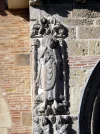 osts very interesting mural paintings in the second floor (free visit).
osts very interesting mural paintings in the second floor (free visit).
The square is also the place of many fairs and activities; it is surrounded by restaurants, cafes and libraries.
To start with pilgrim's places, Saint Sernin was (and is) a mandatory stop, with its crypt housing the relics of many saints (free visit with your credential).
The Saint Etienne cathedral is a marvel of romanesque-gothic architecture, with a chapel dedicated to Saint Jacques.
Cross the river by the Pont Neuf, and you can visit the imposing Hôtel Dieu-Saint Jacques, a former pilgrim's hospital, where you can see the effigy of the apostle presiding over the entrance.
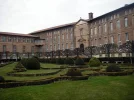
It is not directly related to pilgrimage, but there is a Jacobins monastery (currently a museum) with a grandiose gothic architecture. Other places very worth visiting are the Musée des Augustins with an impressive collection of medieval art; and the Saint Raymond museum, with remarkable Roman art found in excavations (did I say Toulouse is very old?). A personal favorite is the Fondation Bemberg, a remarkable private art collection housed in a Renaissance palace.
For more relaxed activity, a stroll along the Garonne river (a very popular activity in summer) is very pleasant. Or visit the Jardin des Plantes (botanical garden), with a nice little lake, a cascade, ducks, manicured gardens, playing children, etc.; a short walk from metro “Carmes”.
If reading is your thing, visit the bookstore - cafe Ombres Blanches (rue Gambetta, 50, near main square) with comfortable sofas to take a look of books and a very complete section of Camino guides . You can eventually assist here to book presentations, with lively discussions about the thrilling (and abstruse) topics of the French literary scene.
If you are tired, having a coffee or your favorite drink in the arcades surrounding the Capitol square is a very good experience.
Food
France’s Southwest has a distinctive gastronomy. Toulousans are very proud of cassoulet, a hearty dish with a basis of white bean stew and many local variations of meat, although the city’s specialty is made with sausages and duck. Fromages, sausages and desserts are also remarkable.
There are plenty of restaurants, but if you want to get the social experience of French food, go to the popular Marché Victor Hugo (Place Victor Hugo, closed Mondays), where gourmets buy high quality supplies and local people go to enjoy food or a drink. Tables at many restaurants (second floor) are shared; you just see a place, say “excuse moi” and “bonjour” and sit.
Local wines have not the prestige of a Bordeaux, but the inexpensive Gaillac and Fronton varieties are very well worth trying.
Bon appetit!
Leaving
Sadly, sooner or later you have to say goodbye to this charming city.
Leaving Toulouse implies many miles of suburbs; not ugly or unsafe, just uninteresting. You can follow the GR along the river, cross it at the intersection with the A621 highroad and walk besides the Blagnac airport up to Pibrac.
Or follow the alternative proposal of the ACIR association. In this case you cross the Pont Neuf and follow the map indications towards Pibrac. See the map here for both options.
If you prefer to avoid the suburbs, take the train to Pibrac and start walking there, after a visit to its peculiar fortress-church. You can follow then the GR to cross the pleasant Bouconne forest; or take the alternative route (shorter, less scenic) by Leguevin village, with a communal gîte (call before your arrival). In both cases your next stop will be probably L'Isle Jourdain (gîte municipal, other options, see here)
Bon chemin!
............
Updated
4/22: Route options after Pibrac, lodgments in L'Isle Jourdain.
7/16: Adding info about the Via Garona, from Toulouse to SB de Comminges.
(If you have found this guide useful or at least entertaining, please go to my profile and drop a private message )
)
Generalities

Toulouse, also known as "La Ville Rose" (because of the pinkish color of its old buildings) is an ancient, charming and lovely city, the largest of southwestern France. It used to be a quiet provincial place, but in recent times it evolved into a high tech hub, notably with the huge Airbus headquarters. It is also an arts and cultural center, with a vibrant urban life.
And how not to love a city whose official flower is the violet, which symbolizes modesty, gentleness and hidden love? Violets have its own festival dedicated to all things related to the flower, and you can buy violet based sweet treats, cosmetics (soaps, eau de toilette, parfums), scented tea and liqueurs. In early March, usually.
You will notice the street names and metro stations written in Occitan (the old regional language, which predated modern French).

Toulouse has always been an important stop in the Arles way, already mentioned in the medieval chronic of Aymeric Picaud. Also, there is a “transversal” route that links the city with Conques (in the Le Puy way).
It is also possible, with a short hop by train, connect with the scenic Piedmont way, for example in Carcassonne. Or, alternatively, walk to Saint Bertrand de Comminges by the new Via Garona, the GR 861.
Generally speaking, Toulouse is a safe place (and its inhabitants are really, really polite). Anyway, take the usual, common sense precautions you'd use in any big city.
Trains, planes and navettes
If you start your pilgrimage at Toulouse you will arrive by train or plane.
The Matabiau train station is very centric; you can connect there with the metro (see “transportation”, below)
The Blagnac airport is not far from the city. You can take the express bus (navette) that goes every 20 minutes to downtown, with final destination at Matabiau. Not expensive, just 8 euros, and your ticket is also good for the metro for 1 1/2 hour after you bought it. Time to/from downtown: 20 to 45 minutes, depending on the traffic.
Another (and new) option is the tramway line T2. You leave at Arènes and connect to metro with the same ticket. It could be more crowded.
There are taxis at the airport, too.
Arriving by the Arles way
Pilgrims doing the Arles way typically start the previous stage in Baziège (attention: communal gîte closed, currently there is an alternative at Ayguevives). There are two arrival options to Toulouse: the GR (marked with the typical red and white strips signposts) that goes along the Garonne river; and the alternative and popular walk along the Canal (channel) du Midi that drives the walker practically into midtown (see this map), indicated with the familiar arrows and shells (placed high, besides the usual urban signposts).

Credential and stamps
At Basilica of Saint Sernin there is a pilgrim's bureau, managed by volunteers of Amis de Saint Jacques de Compostelle association. It is open from 1st Avril to October 31th, 15h – 18 hs.
Another option is ACIR Compostelle, a public association. It is at Clémence Isaure 4. See opening hours here.
Both places receive pilgrims warmly, and give help and advices.
Lodgment
Well, this is a difficult topic. You can see mentions of some public and ecclesiastical albergues in many guides, but I have never met or read about pilgrims that were actually lodged there (if you have been, send me a message). So, this means hostals or hotels. As Toulouse is a popular tourist spot, there are plenty. For tight budgets, "Le petit auberge de Saint Sernin" (shared rooms, approx. 22 euros) is centric, and has good reviews; for reservations, go to your favorite booking service.
Moving around
It is easy. Most restaurants, monuments, museums and churches are within walking distance.
The metro covers nicely all downtown. Tariffs and options are explained here. Your ticket is also good for the buses, although obviously you will need some mastery of its complicated network.
What to see
A lot. If you have the time, I really recommend that you save an extra day for this city. Start with a visit to the tourism bureau, at central Capitol square, in a former keep; the staff speak main usual languages. The adjacent city hall h
 osts very interesting mural paintings in the second floor (free visit).
osts very interesting mural paintings in the second floor (free visit).The square is also the place of many fairs and activities; it is surrounded by restaurants, cafes and libraries.
To start with pilgrim's places, Saint Sernin was (and is) a mandatory stop, with its crypt housing the relics of many saints (free visit with your credential).
The Saint Etienne cathedral is a marvel of romanesque-gothic architecture, with a chapel dedicated to Saint Jacques.
Cross the river by the Pont Neuf, and you can visit the imposing Hôtel Dieu-Saint Jacques, a former pilgrim's hospital, where you can see the effigy of the apostle presiding over the entrance.

It is not directly related to pilgrimage, but there is a Jacobins monastery (currently a museum) with a grandiose gothic architecture. Other places very worth visiting are the Musée des Augustins with an impressive collection of medieval art; and the Saint Raymond museum, with remarkable Roman art found in excavations (did I say Toulouse is very old?). A personal favorite is the Fondation Bemberg, a remarkable private art collection housed in a Renaissance palace.
For more relaxed activity, a stroll along the Garonne river (a very popular activity in summer) is very pleasant. Or visit the Jardin des Plantes (botanical garden), with a nice little lake, a cascade, ducks, manicured gardens, playing children, etc.; a short walk from metro “Carmes”.
If reading is your thing, visit the bookstore - cafe Ombres Blanches (rue Gambetta, 50, near main square) with comfortable sofas to take a look of books and a very complete section of Camino guides . You can eventually assist here to book presentations, with lively discussions about the thrilling (and abstruse) topics of the French literary scene.
If you are tired, having a coffee or your favorite drink in the arcades surrounding the Capitol square is a very good experience.
Food
France’s Southwest has a distinctive gastronomy. Toulousans are very proud of cassoulet, a hearty dish with a basis of white bean stew and many local variations of meat, although the city’s specialty is made with sausages and duck. Fromages, sausages and desserts are also remarkable.
There are plenty of restaurants, but if you want to get the social experience of French food, go to the popular Marché Victor Hugo (Place Victor Hugo, closed Mondays), where gourmets buy high quality supplies and local people go to enjoy food or a drink. Tables at many restaurants (second floor) are shared; you just see a place, say “excuse moi” and “bonjour” and sit.
Local wines have not the prestige of a Bordeaux, but the inexpensive Gaillac and Fronton varieties are very well worth trying.
Bon appetit!
Leaving
Sadly, sooner or later you have to say goodbye to this charming city.
Leaving Toulouse implies many miles of suburbs; not ugly or unsafe, just uninteresting. You can follow the GR along the river, cross it at the intersection with the A621 highroad and walk besides the Blagnac airport up to Pibrac.
Or follow the alternative proposal of the ACIR association. In this case you cross the Pont Neuf and follow the map indications towards Pibrac. See the map here for both options.
If you prefer to avoid the suburbs, take the train to Pibrac and start walking there, after a visit to its peculiar fortress-church. You can follow then the GR to cross the pleasant Bouconne forest; or take the alternative route (shorter, less scenic) by Leguevin village, with a communal gîte (call before your arrival). In both cases your next stop will be probably L'Isle Jourdain (gîte municipal, other options, see here)
Bon chemin!
............
Updated
4/22: Route options after Pibrac, lodgments in L'Isle Jourdain.
7/16: Adding info about the Via Garona, from Toulouse to SB de Comminges.
(If you have found this guide useful or at least entertaining, please go to my profile and drop a private message



